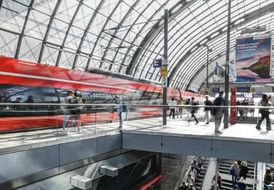Management approach and targets
Focus on digitalization and technology
Our digital and technical strategy is designed to develop an ultra-smart mobility network by 2030 – connected, automated and customer-oriented. In the future, travel should essentially “plan itself” and adapt to changing circumstances in real time in the event of deviations. To this end, our digitalization processes must be understood and designed as an intelligent overall system – a long-term development, with three core tasks under the Strong Rail strategy:
- fully connected,
- self-organized development, and
- making it easier for customers to use mobility services.
The use cases show where digitalization and technology are the key to success for the Strong Rail strategy. We will focus in particular on some of these:
- Digital rail operations, because it makes us more robust, for example, thanks to automated timetables and scheduling.
- Digital maintenance, because it makes us more effective, for example, through more efficient materials management and more powerful forward-looking planning.
- Green rail technology, because it makes us more environmentally friendly, for example, through our emissions-free and environmentally friendly rail operations.
All projects are geared towards the sustainable increase in capacity, efficiency and quality. The implementation is accompanied by a new culture created as part of a Compass for Strong Collaboration, which promotes ideas and plans for new working environments, and encourages enthusiasm for new technologies.
IT infrastructure is the basis for driving the development of digitalization. Five elements form the foundation of the digital infrastructure for a Strong Rail system:
- Connectivity as a basic requirement for data transfer and exchange, because a Strong Rail system needs high-speed communication.
- Cloud services as the basis for rapidly scalable and high-performance storage services, because a Strong Rail system needs efficient and flexible IT resources.
- Cybersecurity as the basis for continuous security in more digitalized rail operations, because only a secure rail system is a Strong Rail system.
- Development platforms as the basis for modular services, IT security and the acceleration of software development, because a Strong Rail system requires high-performance IT.
- Data management as the basis for legally secure, standardized and comprehensive data utilization, because a Strong Rail system needs a clear overview of the Integrated Rail System.
By 2030, the goal is to have trained mobility systems to detect, calculate and network automatically and hence, to keep everything permanently up to date. Artificial intelligence (AI) determines the pace of this by facilitating new ways of managing capacity, eliminating barriers and satisfying requirements before they are even identified and formulated. The vehicles are highly automated, communicate with each other, update themselves independently and report potential defects even before they occur – with new sensors, drones and robots.
Stakeholders are informed about the priorities and progress in implementing both the use cases and the foundations as part of regular informative events. The progress and effectiveness of program and technology projects are reviewed regularly with the responsible business units and Group functions. If necessary, options for action are discussed and decided upon.


